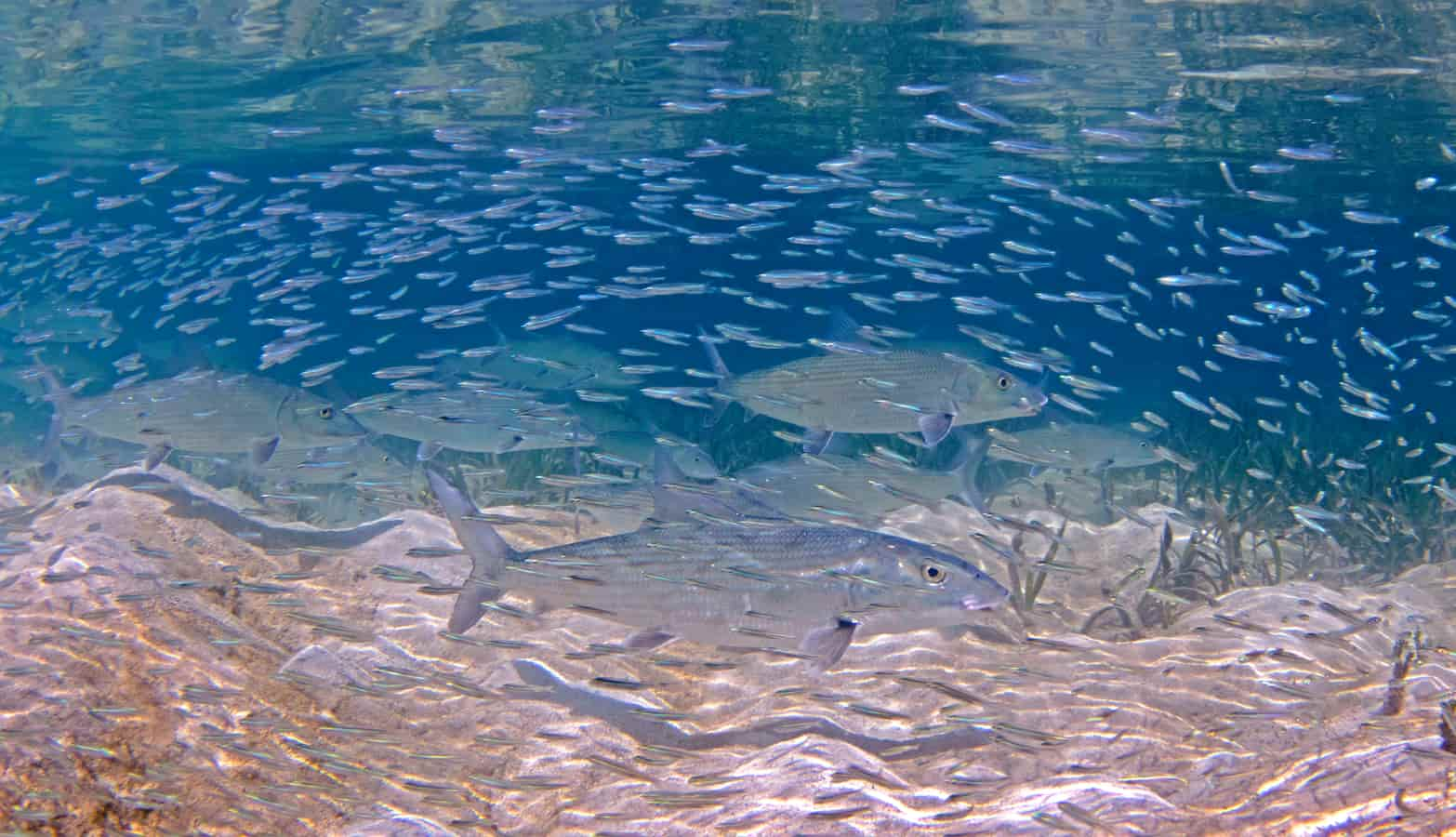The Glyphosate Debate: Looking for Clear Answers in Murky Waters

Image by Pat Clayton
Editor’s note: Conservation/environmental issues are always complex and suggested solutions are never tidy. Dealing with invasive species, both fauna and flora, is a prime example of the need for nuanced thinking paired with careful practices backed by the most up-to-date science. MidCurrent does not have an official stance on the use of chemicals to control invasives other than seeking the best answer to the question: How do we accomplish the most good while inflicting the least amount of damage to ecosystems, native species, and humans?
This question should be at the center of every conservation debate.
I live in Wyoming — a world away from the beaches, atolls, mangroves, and flats of Florida. My saltwater fly fishing experience is limited to surf casting for pink salmon and dolly varden off the coast of Kodiak Island in Alaska.
Over the past few weeks, however, I’ve found myself tangled up in Floridian matters that share a strikingly common thread with issues facing anglers here in the Rockies. I’m invested in a fishery, in an environment I’ve never recreated in, because Florida is suffering from the same lack of stewardship I see here in the Mountain West.
I try not to have an agenda with what I write, especially when it comes to conservation. Every outlet, it seems, has its own slant on how to frame the issues facing our wildlife and wild places. To quote Thoreau, I’d rather have the truth.
The truth is that we, as an American people, own a striking amount of public land. 640 million acres—or about 28% of the total landmass—belongs not to me, or the rancher down the street, but to all of us. And that’s just federally managed land. If we included state lands (which all of us reasonably have access to as well), the number is even higher. With that ownership comes the responsibility to be good stewards of the land, a charge that, in my opinion, we’ve not lived up to.
Evidence for my claim lies, in part, in the myriad of issues facing Florida’s fisheries, but particularly the current debate surrounding glyphosate. Glyphosate is the active ingredient in Roundup, and it’s used by the state of Florida to control invasive plant species that are choking out Florida waterways.
According to Dr. Aaron Adams, Ph.D., the director of science and conservation for the Bonefish & Tarpon Trust (BTT), application of chemicals to remove invasive plants is ubiquitous throughout many state natural resource agencies. That application may actually be doing more harm than good, however.
“When herbicides are applied and the weeds die, they decompose, and all that nitrogen and phosphorus that’s in those plants are returned to the system to be used by the other plants,” Adams said. “At the same time, you have nutrients coming in from human causes, and to some extent, we’re exacerbating the situation by killing them.”
BTT has taken a public position that glyphosate use needs to be eventually eliminated, but Adams says focusing solely on banning glyphosate is “treating the symptom instead of the disease.”
The disease, according to Adams, is the current way of treating and removing invasive plants, particularly in Florida. Adding more chemicals to the waterways only further destroys ecosystems that are already facing serious problems. During my conversation with Adams, he noted that “our fisheries, at least in Florida, are already at a deficit, and that a large portion of habitats have been lost. For example, Florida has lost around 50% of mangroves, about 47% of wetlands, and tarpon and snook depend upon wetlands. Those populations are already working at a deficit of not having enough habitat. Now, within those habitats, you have all those different issues (invasive plants and chemicals in the water) we’ve already talked about.”
That claim from Adams brings up a natural question—is glyphosate actually harmful to the environment?
According to John Wallace, Ph.D, and Dwight Ligenfelter, both from Penn State University, perhaps not.
“Approximately 95% of registered herbicides are molecules made from aromatic ring structures,” Wallace and Ligenfelter wrote. “In comparison, glyphosate is a small molecule made of a linear carbon chain with weaker bonds, which makes glyphosate less persistent in the environment.”
Glyphosate doesn’t stick around in the environment as long as other herbicides, which is why it’s so widely used. In addition, Wallace and Ligenfelter note that this chemical has a “lower acute toxicity to humans than 94% of all herbicides and many common household chemicals, including vinegar and table salt.”
So, if glyphosate isn’t harmful to humans, why is there a push to ban its use? It seems like an effective method for managing invasive plants, doesn’t it?
Well, its impact on humans is still a hotly-debated topic, and it can’t be overlooked that the Penn State study looked at “acute” toxicity compared to long-term toxicity. As the abstract to a 2021 study in Science Direct states, the “carcinogenic potential of Glyphosate based herbicides has been extensively debated issue within many international agencies with contrasting opinions.”
That there’s no consensus on glyphosate’s impacts to humans is unsettling, to say the least. It’s been labeled a carcinogenic substance by attorneys, but has yet to receive that status in the United States. The NIH itself says that “The human, animal and mechanistic evidence indicates that glyphosate cannot be considered as a potent DNA reactive tumour-initiating chemical.”
The NIH also admits that various rulings from Europe labeling glyphosate a carcinogen are at odds with other studies and scientific bodies. The science is anything but settled regarding glyphosate’s impact on humans.
As for its impacts on wildlife? We have some data, but what we’re lacking is a study on glyphosate’s long-term impacts in the marine environment.
One study that BTT cited in a letter to Florida officials specifically cites research performed by the Ocean Research and Conservation Association (ORCA) and the University of Florida. The ORCA study sampled fish from Florida’s Indian River Lagoon, and all 125 fish had glyphosate in them. However, in that letter, no physiological problems were noted. Yes, the fish had glyphosate in them, but was it harming them?
A study from the University of Florida posits that glyphosate does, in fact, harm fish. That study was conducted by taking largemouth bass from a hatchery, placing them in fish tanks in a lab, and exposing them to multiple levels of glyphosate. One tank was exposed to 10mg L-1 of glyphosate, which the study authors claim is “the concentration estimated to occur in water during a contamination event or direct application or spills.” Another tank was exposed to 0.5mg L-1 of glyphosate, which is “below the U.S. EPA maximum contaminant limit permitted for drinking water.”
Both tanks of largemouth bass exposed to glyphosate exhibited kidney damage, among other endocrine issues. The tank of largemouth bass that served as a control population predictably had no issues.
Case closed, right? If glyphosate causes problems to largemouth bass, what else is it doing to fish that haven’t yet been studied?
Not quite. While I appreciate the level of detail that went into conducting the University of Florida study, I question why BTT would hold a laboratory-based study up as the gold standard for potential harms caused to wild fish. Would wild largemouth bass, exposed to those same levels of glyphosate in their natural habitat with natural forage available (the bass in the study were fed salmon broodstock feed once every three days) exhibit the same physiological effects?
Dr. Adams thinks so.
“I don’t expect to see a difference in wild fish versus the fish in the largemouth bass study,” he said. “I’d love to know something in the natural environment that would mitigate a toxin.”
Well, off the top of my head, I can think of one toxin that’s naturally absorbed back into the environment without long-lasting ill effects — rotenone.
Writing for The Salt Lake Tribune in 2023, Ted Williams noted that “In modern fisheries management, rotenone has never been seen to permanently affect a native ecosystem except to restore it. For centuries, Indigenous peoples have used high concentrations to kill fish for consumption. Rotenone only affects gill tissue.”
I understand what Adams is trying to say—that we shouldn’t dump toxins into our wilderness and expect everything to turn out just fine. But some of these toxins aren’t as evil as they’re made out to be (rotenone is just one example).
Glyphosate has become the poster child for BTT’s “Win Back Our Water” campaign, which encourages anglers to support ending “the use of harmful glyphosate in Florida waterways.” Yet Adams repeatedly said during our interview that glyphosate really isn’t the problem; instead, it’s the current model of managing invasive plants that needs our attention. Why, then, make glyphosate the boogeyman? Why pick this herbicide that, in the short term, is proving effective?
“I think part of our concern is that a system has been developed that, in the short term, is cost-effective,” Adams said. “It’s cheaper to spray than it is to do mechanical removal. But as we find out more about the impacts of herbicides, we’re concerned about the long-term impacts of herbicides.”
Alright, I can get on board with concern over long-term impacts of herbicides. But what actual solution is being offered? Are we commissioning an in-depth study on glyphosate’s impact on the marine environment, so we have more than hypotheticals to go on?
“The Izaak Walton League in Florida successfully completed a pilot project on mechanical removal,” Adams said. “They didn’t just remove the vegetation from the waterway; they turned it into a slurry and sprayed it onto fields away from the waterway, assimilated into crops that were then harvested, so they removed the nutrients that were in the invasive weeds.”
Removing the nutrients in the weeds can help reduce future blooms and growth of remaining invasives, since, as Adams already noted, dead plants release nutrients back into the environment that further more plant growth.
Mechanical removal is cited as the logical non-toxic method for managing invasive plants, but it has its limitations. It requires immense amounts of money and personnel, and last I checked, Elon Musk hadn’t rolled out a Cyberboat capable of a carbon-neutral mechanical weed-removal process. Couldn’t we argue the emissions from outboard motors and mechanical weed removal equipment is more harmful overall than glyphosate?
After speaking with Adams, and doing my own research, I’m not convinced that glyphosate is the boogeyman we should be chasing. Instead, we should be demanding better stewardship of our natural resources from all stakeholders, but especially the conservation groups we’ve tasked with carrying out what we, as the sporting public, can’t accomplish on our own. Quit chasing the low-hanging fruit that brings in easy money; instead, put the time and effort into crafting tangible solutions that will directly benefit wildlife.
I don’t have an answer for solving the invasive plant crisis (and anyone who does is selling you something) but I know hysteria isn’t it. I’d rather see conservation groups propose real, thorough solutions to our problems. Solutions that are actionable, that don’t require more “funding” or “study.” Take my native Utah, for example. The Great Salt Lake is drying up, exposing a lakebed full of toxic dust laced with, among other carcinogens, arsenic.
The state of Utah recently released a plan to bring the lake back to “safe” levels by 2050, and some leaders are touting this plan as a major step forward in saving the lake. Once you read through the report, however, you find more of the eventual punting of the issue, all in the name of “study.”
“While the desired outcome of 4,198 feet elevation may not happen anytime soon, the report recommends that Utah begin the planning and conservation work now,” Carter Williams, an outdoors, news, and history reporter for KSL.com, wrote. “To that end, the commissioner’s office is crafting a “detailed plan” in the next year to determine how much water is needed to be cut from every water consumption sector every year to reach the primary goal.”
Instead of acting now, Utah is waiting on more studies before making a decision, when a simple solution is staring them right in the face—quit diverting so much water from the lake.
Yes, it’s painful, but it could be done with the right leadership. Yet all the people involved—including conservation groups—seem more invested in securing money to “study” the problem, rather than find an actual solution.
Which brings us back to BTT’s “Win Back Our Water” campaign. They’re asking us to stop glyphosate use, but offer no realistic alternative we can implement in the short-term. Wouldn’t it be a better use of fundraising to put money towards a long-term study of glyphosate in the marine environment, instead of an outright ban that’s likely to receive pushback from the green and agricultural communities, in addition to rank-and-file homeowners? Without hard-and-fast proof that glyphosate is negatively impacting marine environments (and the sector of Florida’s economy that depends on folks traveling to fish in the Sunshine State), how are we going to convince the average Joe that he needs to quit using Round Up?
I’m glad BTT is speaking out about the overuse of chemicals and trying to raise awareness, but stewardship is about more than speaking up. It’s making the hard decisions that will ultimately benefit our wildlife and wild places in the long run.











